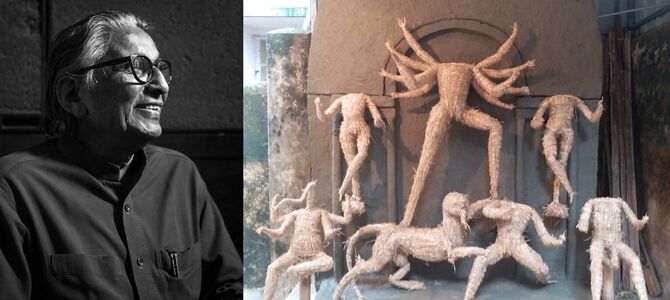What with Durga Pujo around and the artisans in Kumartuli, busy making the idol, I am reminded of Balkrishna Doshi.
Somewhere in the 90’s, the first phase of Harsh Neotia’s Udayan –the condoville got completed. The Architect Balkrishna Doshi came to Calcutta for the opening and expressed his desire to exhibit his work. Harsh decided to sponsor it and thus set the ball rolling.
In the winter Doshi arrived in Calcutta with all his drawings and rendering of different projects and the exhibition was to be held at Birla Academy.He expressed his wish to place the ‘Kathama’, কাঠামো, or the Form of a Durga idol, in the start to the exhibition. as he felt that in Bengal this symbolises the highest form of poetry in architecture.
Harsh discussed with his Man-Friday, Abhijit Banik to get it done. What was felt as an easy task turned out to be difficult! The Durga Puja was long over and the daughter Lakhsmi and Ma Kali had already paid their visits, with Saraswati puja a little far off. Man–Friday has never disappointed and so he set about the task of getting an artisan in Kumartulli to create one, more so because it had to be of exact size to fit the arch which Doshi wanted to create.
At the end, it was done and you were greeted to the exhibition of the famous architect Balkrishna Doshi with only a ‘Kathama’ of Ma Durga . No colour, headless with clay plastered in some places. With Flowers and a Pidim, পিদিম, the picture was surreal. I only do hope somebody had taken a picture and will be kind to post it here.
Today the Poetry in Architecture is Dead. The romance is no longer there. You turn a corner in a quiet spot of Calcutta (there are a few), expecting perhaps some more of the dutiful brick or render that has become the new normal in residential development, and see instead a screen of bricks, solid and load-bearing as masonry should be. Better, the full, glorious range of the material’s surfaces are not on show, rough where it has cleaved along natural faults, and smooth where it has been worked by masons, sometimes scored with parallel lines in the process of extraction.
In his work, Husain-Doshi Gufa, you can see quirks and fossils from the many tens of millions of years of the stone’s making, back to the time when it accumulated on a prehistoric equatorial sea bed. In a little moment of wit, a carved fragment of an lonic pilaster emerges from what looks like a fallen rock. Stone is celebrated as a living thing, animated by geology and workmanship. It is masonry fromagerie, where the same substance has many flavours. It is a joy to see stone treated like this, when it is so often sliced with deadly precision into emaciated veneers.
Academic Block of IIM-Bangalore, was designed and developed by Doshi in a way that greenery are beginning to appear, with creepers wrapping round the pillars, shrubs on the walk way and a small, publicly accessible garden, paved with pebbles, glimpsed through a colonnade at the side. The building hints at being a poetic ode, albeit one with the underlying rectangular regularity of architecture that has become famous for. A certain lightness and transparency offset the stone, as a generous, large-paned apartment building, with classes, lies behind the masonry.
Udayan includes homes for the low income group where the staircase spirals from outside much of what you see in the village of Gujarat. He is an architect who is always singular, never identifiable with one camp or style. His projects tend to differ, one from the other, in materials and detail.
“It’s awful for your imagination and job if you’re doing the same thing again and again,” he says. “It’s not good for your brain.”
The reward, for him and for passers-by, is the creation of buildings for living and working, which manage to add to the richness and enjoyment of their streets. One such is the National Institute of Fashion Technology, Delhi. New windows, deliberately at odds with the hierarchies of the original mouldings and recesses, are punched through. Blemishes in the casting process are left to be enjoyed and make-believe stains are artistically brushed on. The odd detail, such as a bit of rooftop balustrade relocated near ground level, is flipped into a new position.
There’s a clear and acknowledged debt here to the French architect Le Corbusier with whom he worked on the latter's projects in Paris between 1951 and 1954. In 1954, he returned to India to supervise Corbusier's buildings in Ahmedabad, which included the Villa Sarabhai, Villa Shodhan, Mill Owners' Association Building, and Sanskar Kendra.
~
Balkrishna Vithaldas Doshi, born 26 August 1927, is an Indian architect. He is considered to be an important figure of Indian architecture and noted for his contributions to the evolution of architectural discourse in India.
Image : Balkrishna Doshi, image Partha Ranjan Das.
Kathma (কাঠামো ) : Courtesy House Pujo, Rohan Bhattacharya

